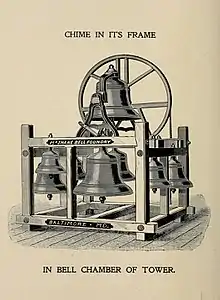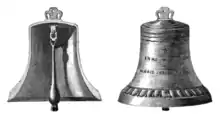Chime (bell instrument)
A chime (/ˈtʃaɪm/) or set of chimes is a carillon-like instrument. It is an idiophone percussion instrument consisting of 22 or fewer cast bronze bells in fixed suspension and tuned in chromatic order so that they can be sounded harmoniously together.

Before 1900, chime bells typically lacked dynamic variation and were not harmonically tuned. Since then chime bells produced in Belgium, the Netherlands, England, and America have tuning to produce fully harmonized music.[1] Some towers in England normally hung for full circle change ringing can be chimed when mouth downwards by an Ellacombe apparatus, or with electro-mechanical actuators.[2][3]
American chimes usually have one to one and a half diatonic octaves. Some chimes are automated.
Etymology
| Look up chime in Wiktionary, the free dictionary. |
The word chime dates back to the 14th century Middle English word chymbe, meaning "cymbal." It probably originates from the Old French chimbe or directly from the Latin cymbalum. The Latin word was shortened in Old French and misinterpreted as chymbe bellen in Middle English, where the meaning shifted by the mid-16th century to "set of bells in a church or clock tower, apparatus or arrangement for striking bells".[4]
Notable chimes
- The Altgeld Chimes at the University of Illinois at Urbana-Champaign. The fifteen bells were cast and installed by the McShane Bell Foundry in 1920. They were a gift of the classes of 1914-1921 and the United States School of Military Aeronautics.[5]
See also
References
- Bell Facts – Bell Chimes Archived 2006-08-13 at the Wayback Machine
- "Glossary of ringing terms". www.cb1.com.
- "Automatic Chiming Systems". John Taylor & Co. Retrieved 5 October 2020.
- "Chime". Online Etymology Dictionary. Archived from the original on 1 May 2019. Retrieved 6 February 2021.
- Anne Lukeman (Producer), Jake Maples (Editor), Nick Yi (Drone footage) (2 August 2017). The Altgeld Chimes (YouTube video). University of Illinois Office of Public Affairs. Retrieved 4 January 2020.
| Wikisource has the text of the 1911 Encyclopædia Britannica article Chime. |

